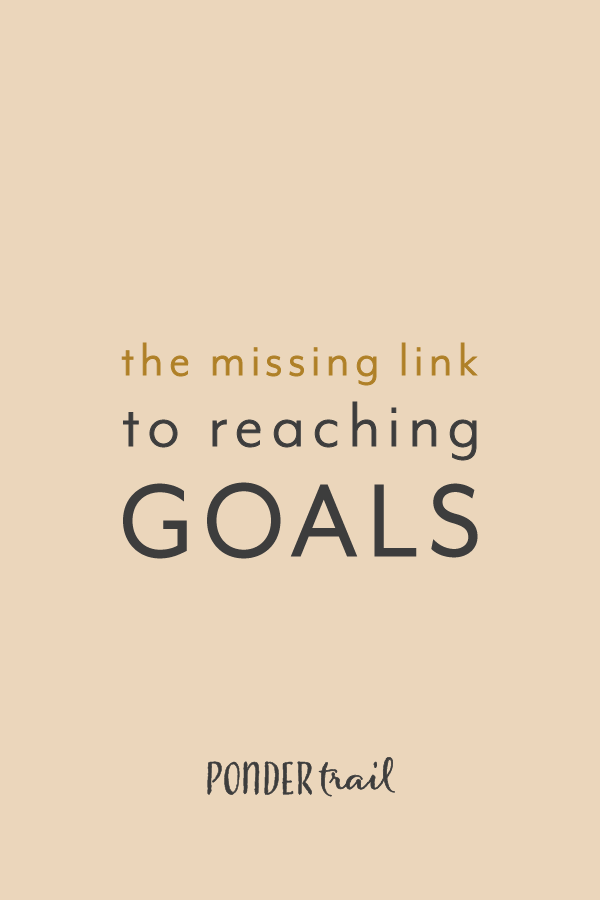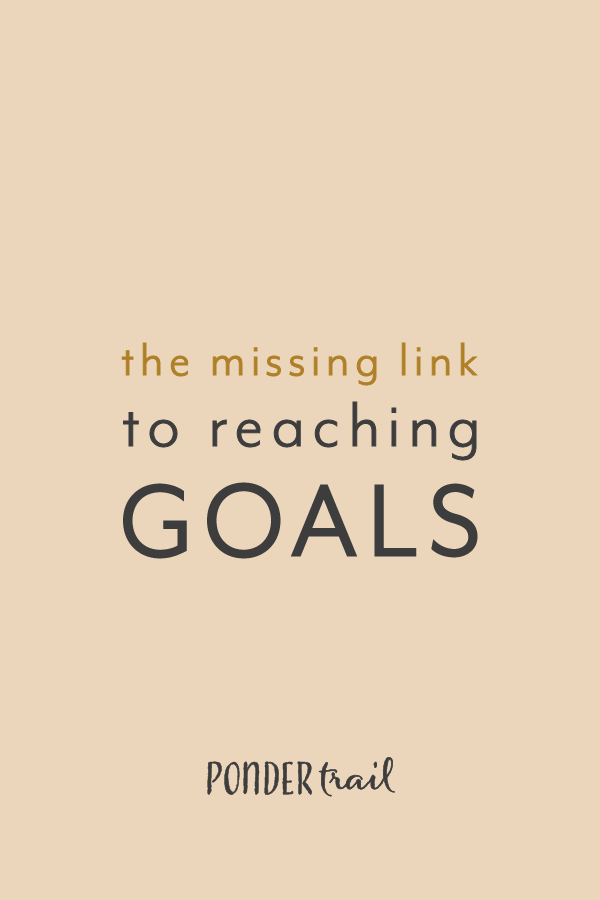The Missing Link to Reaching Goals
Goals.
We set them. We plan them. We reach them, too.
Or at least, we hope we do.
Some goals propel our business forward and help us reach new grounds, while others are critical for simply keeping our business above the water.
There’s something thrilling about reaching a goal—especially after working hard for it day after day. The feeling you get when you finally check one off of your list creates a strong sense of accomplishment and a surge of motivation.
But it can be quite discouraging when you find yourself transferring the same unmet goal over to next month’s planner pages, time and time again, to no avail.
“Maybe next month will be different. Maybe I’ll finally check that one off,” we hope, once again.
But when we are stuck in a cycle and struggle to reach our goals, it’s time to try a different approach.
Last January, while thinking deeply on this subject, I had an epiphany. I figured out the secret to reaching goals—or at least the key I had been missing for years.
I realized there were actually two distinct types of goals, and I was completely missing the mindset behind one of them.
It completely transformed the way I think of goals, how I set them, and how I map them out as a creative entrepreneur.
This blog post sheds light on that secret, and I can’t wait to share it with you!
The Two Type of Goals
Goals can be sorted into two types: internal (independent) and external (dependent). The latter is much more complex and is where we usually get stuck. But let’s dive into the simpler of them first:
Get my workbook for setting, planning, and reaching your goals:
Internal (Independent) Goals
Internal goals are made up of the tasks you can complete independently within your business.
In other words, anything you can hunker down and check off by yourself (or with the help of your team) falls into this category of goals.
They are only dependent on whether or not you follow through and complete their tasks, so reaching them is in your direct control.
While working inside of your business’s bubble, it’s possible to achieve all of these independent goals. The best part is, you can accomplish them even if your business is still hiding under a rock.
Internal goals range from small tasks to big projects and include the habit-, routine-, and productivity-related goals:
Wake up on time each morning to have a productive start
Take photos for an upcoming Instagram batch
Outline and write 3 blog posts each week
Design and create a new product this month
Outline the details of a new service
These goals are straightforward and simple to tackle. And if you are realistic about what you can fit into a day and can stick to your to-do list, you can generally accomplish them. You are mostly in control of what you reach and what you don’t reach since your progress is determined by your actions alone:
You can create a morning routine.
You can learn to follow a focused work schedule.
You can learn how to set a realistic workload for the day.
You can develop better productivity skills.
You can stick to your editorial calendar.
You can even hit share on Instagram.
But even if you have this area covered, internal goals are only part of what keeps a business going.
For example, you can do the hard work of writing blog posts, creating content, and staying productive but still be unable to reach your most crucial goals that keep your business afloat. For most entrepreneurs, it’s a certain amount of income needed each month or year.
The problem is, reaching goals that fall into this second, and more complex, category depends on much more than how well you check off your to-do list each day. This is where we often run into problems.
Which leads us to . . .
External (Dependent) Goals
External goals, on the other hand, depend on actions that are outside of your direct control. They require others to take part in your business in some way.
This means these goals are extra tricky to achieve since there are many more factors, steps, and possibilities in between you and that final outcome. In fact, this ambiguity is often why creative entrepreneurs struggle to grow their businesses.
For example, revenue keeps a business going, but goals related to bringing on clients and getting customers are more difficult to reach. This is because the path that leads to them is abstract since they rely on many external actions—or, more accurately, reactions.
These external goals are mostly related to bookings, sales, sign-ups, followers, revenue, etc.:
Double website traffic this year
Get 5 newsletter sign-ups each day
Book 3 clients for this quarter
Sell 10 products by the end of the month
When it comes to reaching these goals, you’ve likely realized they aren’t as cut-and-dry. They are more out-of-reach and often feel completely out of your control. This is because external goals rely on other people to take the actions necessary—and essentially meet the goal for you.
People often need to feel prompted in some way in order to get on board and carry out a step, or series of steps, that make your goal come true.
Restate your external goals.
Keeping this in mind, we can rewrite your external goals to flip them around. This frames them as external actions that need to take place by someone else.
Twice as many need people need to discover and visit your website this year
5 people to sign up for your newsletter every day
3 people need to decide to become your client and then click “book” this quarter
10 people need to invest in your product by the end of the month
This acknowledges the critical role your audience (and potential audience) plays. And it emphasizes the need for a reliable marketing strategy.
Since this method appears to transfer the factors for success to other people—rather than yourself, it can feel like so much is in the hands of strangers. This is largely true because you need external customers or clients to make your business succeed and grow. But really it’s up to you to make it all happen.
When you’re not sure how you will get people to do those steps, however, it can create a catch-22 that makes you feel a bit helpless in reaching your goals.
So how do we put ourselves back in control of making our goals a reality?
Well, while you can't guarantee or control the actions of other people, you can guide them!
In tomorrow’s blog post, I’ll be sharing the simple steps I’ve found to be most effective for reaching goals and how to stop delaying them month after month.
If you enjoyed this post on the missing link to reaching goals, we will be applying this mindset and talking about how to create a marketing strategy for your business. You’ll come away with tips for guiding your audience along the paths that lead to your most important goals. So stay tuned for 6:00 am tomorrow, right here on the Ponder Trail blog! I’ll see you then!
Related post: 3 Goal Setting Hang-Ups, and Solutions for Each
What epiphanies have you had with setting goals? Do you have any favorite tips to share? I’d love to hear from you! Leave a comment below!
Get my workbook for setting, planning, and reaching your goals:
















